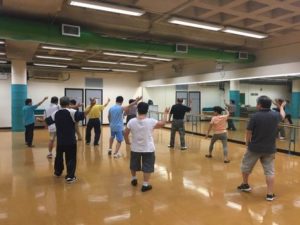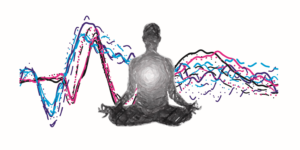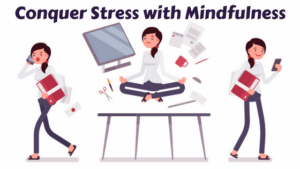Improve Effortless Awareness Meditation with EEG Neurofeedback
By John M. de Castro, Ph.D.
“Neurofeedback meditation supercharges your brain’s ability to learn and in this case it’s learning to go into profound states of meditation where an aspect of that state is rock solid focus and a quiet mind.” – Jonathan Banks
Meditation training has been shown to improve health and well-being. It has also been found to be effective for a large array of medical and psychiatric conditions, either stand-alone or in combination with more traditional therapies. As a result, meditation training has been called the third wave of therapies. But, meditation can be challenging to learn and many people become discouraged and drop the practice. But, modern neuroscience has developed a tool called neurofeedback that can assist the meditator in improving the meditative experience.
In today’s Research News article “Source-space EEG neurofeedback links subjective experience with brain activity during effortless awareness meditation.” (See summary below or view the full text of the study at: https://www.ncbi.nlm.nih.gov/pmc/articles/PMC5001938/ ), Lutterveld and colleagues recruited novice and experienced (> 5 years) meditators. Novice meditators were taught to bring about a meditative state of effortless that consists of “concentration”, “observing sensory experience”, “not ‘efforting’“ and “contentment”. Experienced meditators were simply instructed to enter a state of effortless awareness. During the meditation the EEG was recorded and the activity of the brain waves in the gamma region (40-57 Hz) from the Posterior Cingulate Cortex (PCC) were recorded. The amount of activity was fed back to the participant in the form of a bar on a monitor screen the increased in size as the amount of activity increased.
They found that both groups reported that when they were experiencing effortless awareness the PCC Gamma activity was low. In addition, both groups were able to decrease the PCC Gamma activity when they tried. These results suggest that neurofeedback can be used to alter brain activity in targeted areas and frequency ranges. The Posterior Cingulate Cortex (PCC) is known to be a key structure in what is termed the default mode network. This network becomes active during times when the mind is wandering or in self-referential thought. So, the lowering of PCC Gamma activity with neurofeedback would suggest that the meditators are able to volitionally control mind wandering when appropriate feedback is available.
Since PCC Gamma activity is associated with effortless awareness these results suggest that neurofeedback can be used to train individuals to increase the amount of effortless awareness present in their meditation and decrease the amount of mind wandering. This in turn could markedly increase the quality of the meditation practice. Future research should explore the application of this neurofeedback for the improvement of meditation practice and its associated benefits.
So, improve effortless awareness meditation with EEG neurofeedback.
“If you meditate for an ulterior motive, that is to say, to improve your mind, to improve your character, to be more efficient in life, you’ve got your eye on the future and you are not meditating. Because the future, is a concept. It doesn’t exist.” – Alan Watts
CMCS – Center for Mindfulness and Contemplative Studies
This and other Contemplative Studies posts are also available on Google+ https://plus.google.com/106784388191201299496/posts and on Twitter @MindfulResearch
Study Summary
Van Lutterveld, R., Houlihan, S. D., Pal, P., Sacchet, M. D., McFarlane-Blake, C., Patel, P. R., … Brewer, J. A. (2017). Source-space EEG neurofeedback links subjective experience with brain activity during effortless awareness meditation. NeuroImage, 151, 117–127. http://doi.org/10.1016/j.neuroimage.2016.02.047
Abstract
Background
Meditation is increasingly showing beneficial effects for psychiatric disorders. However, learning to meditate is not straightforward as there are no easily discernible outward signs of performance and thus no direct feedback is possible. As meditation has been found to correlate with posterior cingulate cortex (PCC) activity, we tested whether source-space EEG neurofeedback from the PCC followed the subjective experience of effortless awareness (a major component of meditation), and whether participants could volitionally control the signal.
Methods
Sixteen novice meditators and sixteen experienced meditators participated in the study. Novice meditators were briefly trained to perform a basic meditation practice to induce the subjective experience of effortless awareness in a progressively more challenging neurofeedback test-battery. Experienced meditators performed a self-selected meditation practice to induce this state in the same test-battery. Neurofeedback was provided based on gamma-band (40–57 Hz) PCC activity extracted using a beamformer algorithm. Associations between PCC activity and the subjective experience of effortless awareness were assessed by verbal probes.
Results
Both groups reported that decreased PCC activity corresponded with effortless awareness (P<0.0025 for each group), with high median confidence ratings (novices: 8 on a 0–10 Likert scale; experienced: 9). Both groups showed high moment-to-moment median correspondence ratings between PCC activity and subjective experience of effortless awareness (novices: 8, experienced: 9). Both groups were able to volitionally control the PCC signal in the direction associated with effortless awareness by practicing effortless awareness meditation (novices: median % of time =77.97, P=0.001; experienced: 89.83, P<0.0005).
Conclusions
These findings support the feasibility of using EEG neurofeedback to link an objective measure of brain activity with the subjective experience of effortless awareness, and suggest potential utility of this paradigm as a tool for meditation training.
https://www.ncbi.nlm.nih.gov/pmc/articles/PMC5001938/









